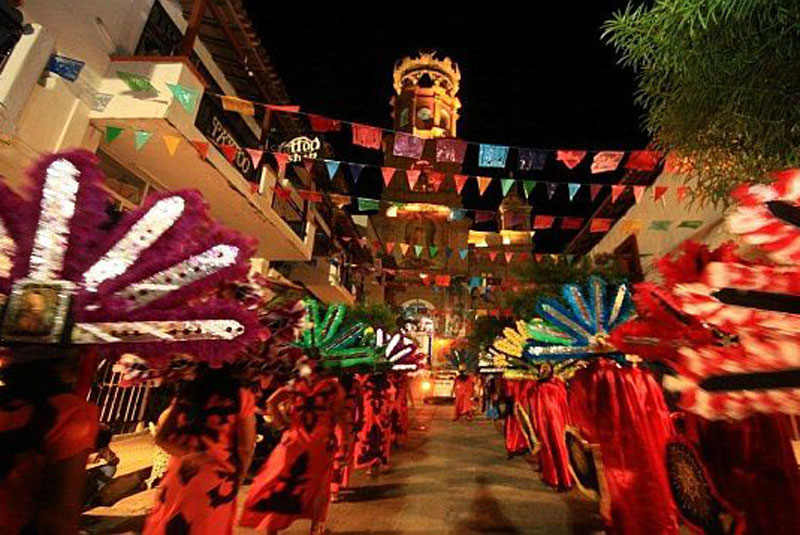
¡Felices Fiestas! How Christmas is Celebrated in Mexico
Rich in traditional festivities, a Mexican Christmas is filled with joy and wonder. A nonstop ride of fiestas and fun, the holiday season begins on December 1st and is joyously extended through February 2nd.
To say that Mexico is a country rich with tradition is clichéd nearly as much as some of the traditions themselves. Take, for example, Mexico’s many Christmas traditions. In other countries, the 12 Days of Christmas are recognized, but in Mexico, the holiday season begins on December 1 and joyously continues until February 2.
The first twelve days of December honor the Virgin of Guadalupe. Every morning begins with the sound of church bells ringing, and every evening the faithful make their way through the city in traditional Peregrinations (pilgrimages) to the Our Lady of Guadalupe Cathedral in downtown Puerto Vallarta, many times dressed in white and carrying candles as they sing her praises.
December 12 is El Día de Nuestra Señora de Guadalupe, in remembrance of when the Virgin Mary left her image imprinted upon a cloth as a way of revealing herself and her identity to a Mexican peasant back in 1531. The cloth is currently housed at the Basilica of Our Lady of Guadalupe in México City, but Puerto Vallarta immortalizes the virgin with statues and flowers erected in her honor. December 12 also marks the day that Puerto Vallarta was founded, so after the religious ceremony, festive celebrations continue with parades, music, singing, dancing, fireworks, and a plethora of street food vendors offering an array of Mexican delicacies on the Malecón.
From December 16th until the 24th, Las Posadas, candlelight processions reenacting Mary and Joseph’s quest for lodging in Bethlehem, are held throughout the city. Acted out by local children, these pilgrims try door after door until they’re finally invited in for the night. Every evening, a different host is chosen, and it’s their task to throw a massive party. Piñatas are common at these parties and normally the shape of a seven-pointed star, representing the 7 Deadly Sins, to be bashed and mutilated, only to produce sweets and treats for the children.
The ninth evening of Las Posadas is December 24, Buena Noche, or Christmas Eve. The children lead a procession to the church and place a figure of the Christ Child in the Nacimiento (nativity scene) there. Later, everyone attends midnight mass, called the Misa de Gallo, (Rooster’s Mass).
After mass, families return home for a festive dinner and traditional drinks before gifts are opened, piñatas are broken and sparklers light up the night.
December 25th, Navidad, or Christmas Day, is considered a time to rest, recover, and enjoy the leftovers!
On December 28th, Mexicans observe Día de Los Santos Inocentes, their version of April Fool’s Day. If any person has fallen victim of the joke, the person pulling the joke will say “Inocente Palomita,” literally meaning ‘innocent little dove.’
After New Year’s Eve, the parties continue until January 6th, known as El Dìa de Los Reyes (Three Kings Day.) It commemorates the time when, according to legend, Los Reyes Magos, (three wise men) Melchor, Gaspar, and Baltazar, arrived at the manger in Bethlehem to pay homage to the Christ child with gifts of gold, frankincense, and myrrh.
This is the traditional day for Mexican children to receive Christmas presents. At a special Twelfth Night supper, families and friends enjoy hot chocolate flavored with vanilla and cinnamon, and a ring-shaped, bread-like cake, called Rosca de Reyes. Hidden inside is a small figure of a baby, representing the Infant Jesus. The person who gets the piece with the figurine is responsible for buying the tamales for El Día de la Candelaria, or Candlemas, February 2.
The Mexican Christmas season is joyously extended through February 2 when the nativity scene is put away, and another family dinner of delicious tamales and atole (a hot, sweet drink thickened with corn flour) is served with great love and happiness. This celebration is the last of the Christmas festivities, 40 days after the birth of Jesus.
